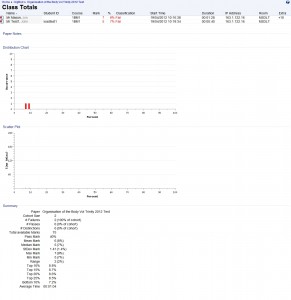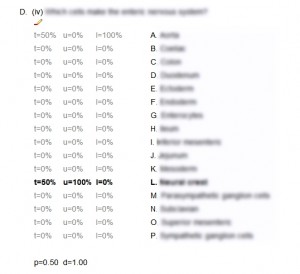During our first live test of Rogo, we were somewhat alarmed when the students pointed out that one of the questions was missing an image. Although far from ideal, it was thankfully not disastrous, as it was noticed fairly early on and we were able to print out a copy of the image for all the students.
The question is, what happened to this image? The paper was checked thoroughly against the QuestionMark Perception version of the paper immediately after it was imported, so it would have been spotted at that point had it not come through in the import. However, I clearly did not check the paper thoroughly enough immediately before the exam, as the image was not there.
So the image was lost from the question between it being imported into Rogo and the paper being taken. To find out when and why, I reimported just this question. The image is there in the QTI XML export from Perception, and was there in the question immediately after import. However, after saving the question from the edit screen, without having made any changes to the question, the image had disappeared. The table cell that should contain the image was left just containing an .
We presumed there was something in the imported HTML that was causing this to occur. Initially we thought it might be that there was no closing tag for the <IMG …> (nor a closing slash at the end of the tag), but adding this made no difference, and there were other questions that have the same lack of closing tag and there were no problems with these. On closer inspection of the html for the questions, we noticed that there was a span in the question intro in the faulty question that was not there in any others. This span contained some attributes that came from MS Word:
<SPAN style=”mso-bidi-font-family: Arial; mso-hansi-font-family: Arial” lang=EN-GB><STRONG>diaphragm <BR></STRONG></SPAN>
Removing the span altogether fixed the problem, so we drilled down in order to identify what aspect of the tags was causing it. We looked into the following:
- The <br> inside span the span? Moving it outside made no difference
- No quotation marks around EN-GB? Adding them made no difference
- The lang attribute? Removing it made no difference
- Non-standard CSS properties in style attribute? Removing the styles fixed the problem
Although it is nice to have found the specific cause, there is no reason for this span to exist at all, so we have removed it completely from the imported version. Hopefully questions containing spans such as this will be few and far between, but since many questions are copied in from Word, care needs to be taken, as it seems that the Rogo text editor, not unusually, does not like them.
For future imports, a quick find/replace through the QTI XML exports when we transfer questions en masse from Perception to Rogo should enable us to remove problematic spans. We will have to do some modification of the XML anyway (e.g. changing the path to images), so it will not be much more work to sort this out as well. I have also blogged about other issues relating to importing questions.


